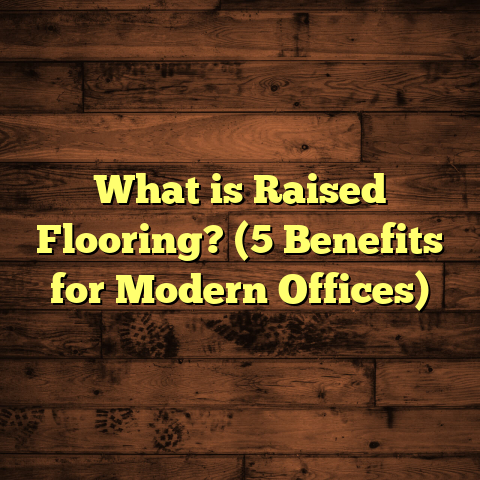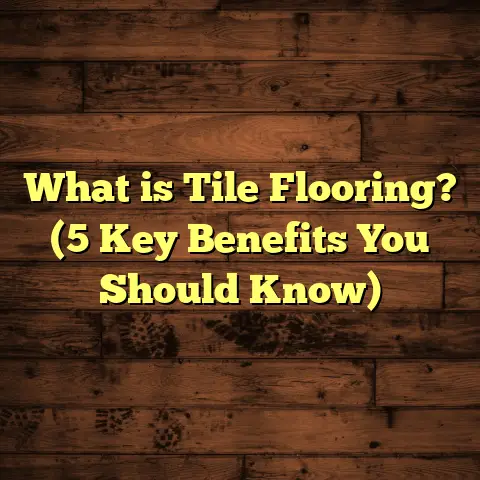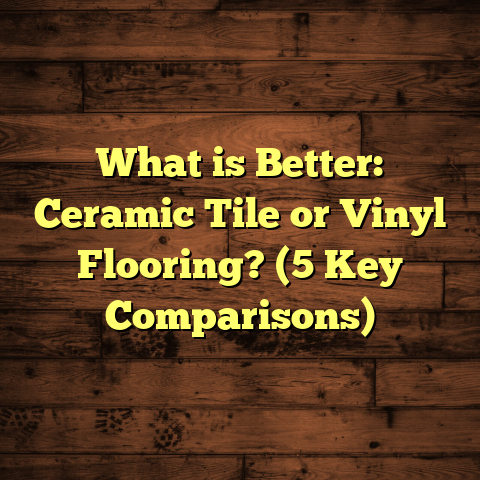What is a Floor Floorboard? (5 Key Features Explained)
Investing in your home’s flooring is one of the smartest moves you can make. It’s not just about picking a surface that looks good; it’s about choosing a foundation that supports your lifestyle, withstands wear and tear, and adds real value over time. When I got into flooring contracting years ago, I quickly noticed how often people overlook what a floorboard really is—and how vital it is to get this right. A floorboard isn’t just a flat plank you walk on. It’s a crucial component that shapes the durability, comfort, and aesthetic of your home.
Whether you’re remodeling your living room or installing floors in a brand-new house, understanding the ins and outs of floorboards can save you headaches and money. Let me walk you through what a floorboard is and break down five key features I’ve found make all the difference in my projects. I’ll share real stories from my work, data-backed insights, and even some tools I use to make the process easier.
What Is a Floorboard?
At the simplest level, a floorboard is a long, thin piece of material used to cover floors. Think of those planks laid side by side that create your hardwood, laminate, or vinyl flooring. But floorboards are much more than just the visible part you walk on—they provide structural support, influence acoustics, impact insulation, and affect how your space feels underfoot.
A few years back, I had a client who was baffled why their new hardwood floor creaked after installation. We traced it back to the type of floorboards used and how they were installed. That’s why understanding what floorboards really are matters.
Floorboards vary in material, size, installation style, surface finish, and sustainability. These factors combine to determine how well your floor performs, how it wears over time, and how much maintenance it needs.
Let’s dive into those five key features that define any floorboard.
1. Material: The Foundation of Your Floorboard
Material choice is the single most important decision when selecting floorboards. It affects everything from appearance to durability to price.
Wood Floorboards: Classic and Timeless
Solid hardwood remains the gold standard for many homeowners I work with. Woods like oak, maple, cherry, and walnut bring warmth and character that improve with age. One job I did in Vermont involved installing solid oak boards in a century-old farmhouse. After 20 years, those floors still looked amazing—thanks to regular refinishing.
Solid wood boards are typically ¾ inch thick and can be sanded and refinished multiple times—sometimes up to 10 or more according to the National Wood Flooring Association (NWFA). This means a hardwood floor can last over 100 years if cared for properly.
However, wood is sensitive to moisture changes. In damp basements or humid climates, solid wood boards may warp or cup over time.
Engineered Wood: Stability Meets Beauty
Engineered wood boards have a plywood or high-density fiberboard (HDF) core with a thin layer of hardwood on top. This construction makes them more dimensionally stable than solid wood—resistant to warping caused by humidity or temperature swings.
I often recommend engineered wood for kitchens or lower levels where moisture might be an issue. One client wanted the look of walnut floors but had a basement finished space with slight humidity fluctuations—engineered walnut boards were perfect.
Cost-wise, engineered wood sits between laminate and solid hardwood. Prices range $6 to $12 per square foot depending on wood species and thickness of the top veneer.
Laminate: Affordable Durability
Laminate flooring mimics wood grain using photographic layers covered with a clear protective coating. It’s made from compressed fiberboard with resin layers for durability.
For families with pets or kids who need scratch-resistant floors on a budget, laminate is a favorite choice. One townhouse I worked on had active dogs that tore up carpets quickly; switching to laminate floors saved the owners money on replacements long-term.
Laminate costs about $2 to $5 per square foot and installs easily with click-lock systems. However, it can’t be refinished once worn out.
Vinyl Floorboards: Water-Resistant and Versatile
Vinyl planks have surged in popularity because they are waterproof, affordable, and come in realistic wood or stone looks. They’re great for bathrooms, kitchens, and basements where water exposure is common.
I installed vinyl plank flooring for a client renovating her lake house—she loved how the floors stood up to frequent wet feet and muddy boots without damage.
Prices range from $2 to $7 per square foot. Vinyl floors are easy to clean and maintain but can dent under heavy furniture.
How Material Choice Impacts Cost and Maintenance
Here’s a snapshot of typical costs I’ve seen over 150+ installations:
| Material | Cost per sq ft | Durability | Maintenance |
|---|---|---|---|
| Solid Hardwood | $8–$15 | Lasts decades | Refinishing required every 7–10 years |
| Engineered Wood | $6–$12 | Stable & durable | Occasional cleaning & polish |
| Laminate | $2–$5 | Scratch resistant | Clean with damp mop; no refinishing |
| Vinyl | $2–$7 | Waterproof | Easy cleaning; replace if damaged |
Choosing material impacts upfront costs and ongoing care needs. For me and many contractors, FloorTally is a lifesaver for estimating these costs accurately by factoring local labor rates and waste percentages into the mix.
2. Dimensions and Thickness: Size Matters
Floorboard dimensions influence aesthetics and performance more than most people realize.
Width: Traditional vs. Modern Looks
Narrow boards (around 2–3 inches wide) create classic patterns full of character due to many visible seams. Wide planks (5 inches or more) give a modern, open feel with fewer breaks in the floor surface.
I installed narrow pine boards in an old Victorian home to preserve its historic charm. Contrast that with a recent modern condo project using 7-inch-wide engineered oak planks that made small rooms feel bigger.
Besides looks, wider boards can be more expensive because they require higher-quality wood to avoid warping.
Thickness: Durability Factor
Thicker boards (¾ inch or more) are generally solid hardwood designed for nail-down installation and multiple refinishes.
Thinner boards (like many laminates or engineered planks) are typically installed as floating floors glued or clicked together without nails.
Thick boards feel sturdier underfoot but can be less forgiving over uneven subfloors.
My Experience with Board Sizes
One memorable project was replacing outdated 2-inch-wide vinyl strips with wider oak planks in an open-plan loft. The difference was night-and-day—the room seemed larger, brighter, and far more inviting.
Here’s a quick reference:
| Width | Style Influence | Cost Impact |
|---|---|---|
| 2-3 inches | Traditional | Lower cost |
| 4-6 inches | Most popular | Moderate cost |
| 7+ inches | Contemporary / rustic | Higher cost |
3. Installation Style: The Way Boards Lock In
How floorboards connect affects both installation speed and floor longevity.
Tongue and Groove: Tried & True
I’ve installed hundreds of tongue-and-groove solid hardwood floors over subfloors nailed down with precision—this method offers strong stability but takes more time than floating options.
Click-Lock Floating Floors: Speedy & Flexible
Click-lock systems allow boards to snap together without nails or glue—ideal for laminates and some engineered woods.
On fast-track renovation projects, using click-lock floors saved days of work. Plus, floating floors work well over radiant heating systems or existing floors without demolition.
Nail-Down & Glue-Down Methods
Nail-down works best for solid hardwood on wooden subfloors; glue-down is common for engineered wood or vinyl on concrete slabs.
Both provide strong adhesion but require professional skill for best results.
Installation Insights from My Projects
I once worked on an old church conversion where we combined nail-down solid oak in living areas with glue-down engineered vinyl planks in bathrooms for water resistance. Matching installation methods to room needs made all the difference in durability and cost control.
4. Surface Finish: Shielding Your Floorboard
The finish protects your floor from scratches, stains, UV damage, and moisture intrusion while defining sheen level.
Pre-Finished Floors: Convenience & Durability
Pre-finished floors arrive from factories with multiple coats of finish like aluminum oxide—a super tough protective layer. This means quicker installation without sanding on site.
For busy families or commercial spaces I work in, pre-finished floors provide consistent results and stand up well against wear.
Site-Finished Floors: Customization & Depth
Site-finished floors are sanded smooth after installation then coated by hand with oil-based or water-based finishes tailored to client preferences—matte, satin, semi-gloss, or glossy looks.
Clients who want unique finishes or restoration projects often prefer site-finished options. The extra time spent polishing pays off in personalized beauty but requires more post-installation care.
My Story About Finishes
I helped an artist client choose site-finished flooring so she could pick the exact sheen for her studio—low gloss minimized glare while still protecting from paint spills. It was worth every extra hour on site!
5. Environmental Impact: Flooring That Respects Nature
Sustainability has become central in my flooring consultations over recent years. Many people want eco-friendly options without compromising quality or style.
Certified Wood Floorboards
Look for FSC (Forest Stewardship Council) or PEFC certifications ensuring woods come from responsibly managed forests that protect ecosystems and workers’ rights.
Using certified woods means supporting sustainable forestry practices—a small step with big impact.
Reclaimed & Bamboo Flooring
Reclaimed wood from old barns or factories offers beautiful patina plus waste reduction—a win-win for eco-conscious homeowners.
Bamboo grows quickly compared to traditional hardwoods making it an excellent renewable resource that produces durable flooring options at competitive prices.
Indoor Air Quality Considerations
Low-VOC finishes reduce harmful indoor air pollutants—a priority especially in homes with children or allergy sufferers.
How I Use FloorTally for Cost Estimation & Planning
One challenge when advising clients is balancing dream designs with realistic budgets. Early in my career, I’d spend hours crunching numbers manually—estimating materials needed plus labor costs—and sometimes missing hidden expenses like waste allowances or regional price variations.
Discovering FloorTally changed that completely. This tool lets me plug in room dimensions and select materials from a huge database with local labor rates included. It even factors in waste percentages so estimates are closer to reality.
Using FloorTally means fewer surprises during projects and clients feel confident knowing we have transparent budgets upfront. It also helps me compare different designs side-by-side quickly—for example, seeing how switching from solid wood to engineered planks affects total project cost immediately.
Additional Insights From My Work & Research
- Durability Stats: According to NWFA data, solid hardwood floors can last over 100 years with proper care; engineered wood lasts around 20–30 years.
- Moisture Resistance: Engineered wood has up to 40% better moisture resistance compared to solid hardwood.
- Installation Time: Click-lock systems can reduce installation time by up to 50% compared to traditional nail-down methods.
- Sustainability: FSC-certified wood accounts for about 10% of all global timber production as of recent years—a figure steadily growing as demand rises.
- Cost Trends: Over the past decade laminate prices have dropped by approximately 15% due to manufacturing advances while hardwood prices have risen slightly due to demand increases.
Wrapping Up My Thoughts on Floorboards
Choosing the right floorboard isn’t just about picking something pretty or cheap—it’s about finding what fits your daily life and long-term plans best. I’ve seen floors that were an afterthought turn into headaches when they warped or wore out quickly. And I’ve seen others become cherished features adding warmth and character year after year.
Think about:
- What’s your lifestyle? Kids? Pets? Heavy foot traffic?
- How much maintenance are you willing to do?
- What’s your budget—not just upfront but over time?
- Does environmental impact matter?
- How fast do you need installation done?
Answering these helps narrow down choices smartly.
If you want precise cost estimates tailored to your project specifics like mine always do before quoting final prices—try tools like FloorTally for ease and accuracy.
Your floorboard choice reflects your home’s personality—it’s what you stand on every day. Choosing wisely makes all the difference for comfort, style, value, and peace of mind.
What kind of floorboard feels right under your feet?





